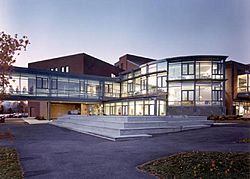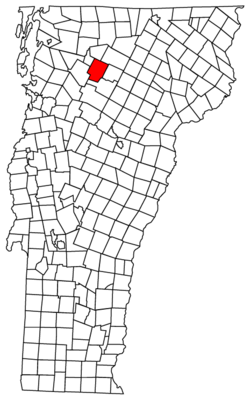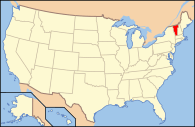Johnson, Vermont facts for kids
Quick facts for kids
Johnson, Vermont
|
|
|---|---|

Northern Vermont University-Johnson
|
|

Located in Lamoille County, Vermont
|
|

Location of Vermont within the U.S.A.
|
|
| Country | United States |
| State | Vermont |
| County | Lamoille |
| Chartered | 1792 (Vermont) |
| Communities | Johnson East Johnson |
| Area | |
| • Total | 45.1 sq mi (116.8 km2) |
| • Land | 44.7 sq mi (115.8 km2) |
| • Water | 0.4 sq mi (1.0 km2) 0.84% |
| Population
(2020)
|
|
| • Total | 3,491 |
| • Density | 78/sq mi (30.1/km2) |
| • Households | 1,349 |
| • Families | 750 |
| Time zone | UTC-5 (EST) |
| • Summer (DST) | UTC-4 (EDT) |
| ZIP code |
05656
|
| Area code(s) | 802 |
| GNIS feature ID | 1462129 |
Johnson is a town in Lamoille County, Vermont, United States. About 3,491 people lived there in 2020.
Johnson is home to Northern Vermont University-Johnson, a college that is part of the Vermont State Colleges system. The Vermont Studio Center, a place for artists and writers, is also in the village of Johnson. Since 1842, the famous Johnson Woolen Mills has been making warm clothes here.
Contents
Exploring Johnson's Location
Johnson is located in the middle of Lamoille County. It sits in the valley of the Lamoille River. The tall Green Mountains rise up both north and south of the river.
The main village of Johnson is in the center of the town. This is where the Gihon River flows into the Lamoille River. Vermont Route 15 goes through the middle of town, following the Lamoille River. This road leads to nearby towns like Hyde Park and Jeffersonville. Another road, Vermont Route 100C, goes northeast from Johnson village.
Land and Water in Johnson
The town of Johnson covers a total area of about 45.1 square miles (116.8 square kilometers). Most of this area is land. Only a small part, about 0.4 square miles (1.0 square kilometer), is water.
Johnson's Weather and Climate
Johnson experiences a typical New England climate with four distinct seasons. Summers are generally warm, while winters are cold and snowy.
| Climate data for Johnson 2 N, Vermont, 1991–2020 normals, 2013-2020 snowfall: 980ft (299m) | |||||||||||||
|---|---|---|---|---|---|---|---|---|---|---|---|---|---|
| Month | Jan | Feb | Mar | Apr | May | Jun | Jul | Aug | Sep | Oct | Nov | Dec | Year |
| Mean daily maximum °F (°C) | 24.1 (−4.4) |
27.6 (−2.4) |
36.1 (2.3) |
50.3 (10.2) |
63.4 (17.4) |
71.2 (21.8) |
75.9 (24.4) |
74.3 (23.5) |
67.7 (19.8) |
54.4 (12.4) |
41.6 (5.3) |
30.3 (−0.9) |
51.4 (10.8) |
| Daily mean °F (°C) | 14.4 (−9.8) |
17.1 (−8.3) |
26.3 (−3.2) |
40.0 (4.4) |
52.7 (11.5) |
61.2 (16.2) |
65.8 (18.8) |
64.1 (17.8) |
56.9 (13.8) |
45.0 (7.2) |
33.7 (0.9) |
22.1 (−5.5) |
41.6 (5.3) |
| Mean daily minimum °F (°C) | 4.6 (−15.2) |
6.6 (−14.1) |
16.4 (−8.7) |
29.7 (−1.3) |
41.9 (5.5) |
51.2 (10.7) |
55.6 (13.1) |
53.8 (12.1) |
46.0 (7.8) |
35.6 (2.0) |
25.7 (−3.5) |
13.9 (−10.1) |
31.7 (−0.1) |
| Average precipitation inches (mm) | 2.81 (71) |
2.38 (60) |
2.77 (70) |
3.79 (96) |
5.04 (128) |
4.65 (118) |
4.49 (114) |
4.37 (111) |
4.04 (103) |
5.16 (131) |
3.74 (95) |
3.59 (91) |
46.83 (1,188) |
| Average snowfall inches (cm) | 24.0 (61) |
30.6 (78) |
22.7 (58) |
6.0 (15) |
0.8 (2.0) |
0.0 (0.0) |
0.0 (0.0) |
0.0 (0.0) |
0.0 (0.0) |
0.6 (1.5) |
14.5 (37) |
20.0 (51) |
119.2 (303.5) |
| Source 1: NOAA | |||||||||||||
| Source 2: XMACIS (snowfall) | |||||||||||||
How Johnson Got Its Name
The town of Johnson is named after William Samuel Johnson. He was an important American lawyer, politician, and teacher.
Originally, this area was known as the "King's College Tract." This name came from a special paper given by British King George III in 1774. The land was meant for the future growth of King's College in New York. Today, that college is known as Columbia University. After the United States became independent, the land was given to William Samuel Johnson in 1785.
People of Johnson
The number of people living in Johnson has changed over time. Here's a look at the population from different years:
| Historical population | |||
|---|---|---|---|
| Census | Pop. | %± | |
| 1790 | 93 | — | |
| 1800 | 341 | 266.7% | |
| 1810 | 494 | 44.9% | |
| 1820 | 778 | 57.5% | |
| 1830 | 1,079 | 38.7% | |
| 1840 | 1,410 | 30.7% | |
| 1850 | 1,381 | −2.1% | |
| 1860 | 1,526 | 10.5% | |
| 1870 | 1,558 | 2.1% | |
| 1880 | 1,495 | −4.0% | |
| 1890 | 1,462 | −2.2% | |
| 1900 | 1,391 | −4.9% | |
| 1910 | 1,526 | 9.7% | |
| 1920 | 1,478 | −3.1% | |
| 1930 | 1,378 | −6.8% | |
| 1940 | 1,420 | 3.0% | |
| 1950 | 1,527 | 7.5% | |
| 1960 | 1,478 | −3.2% | |
| 1970 | 1,927 | 30.4% | |
| 1980 | 2,581 | 33.9% | |
| 1990 | 3,156 | 22.3% | |
| 2000 | 3,274 | 3.7% | |
| 2010 | 3,446 | 5.3% | |
| 2020 | 3,491 | 1.3% | |
| U.S. Decennial Census | |||
In 2000, there were 3,274 people living in Johnson. Most of the people were White (96.58%). A small number of people were Black, Native American, or Asian. Some people were also from two or more races.
The average age of people in Johnson in 2000 was 26 years old. About 21.6% of the population was under 18 years old. Many young adults aged 18 to 24 also lived there, often because of the university.
Famous People from Johnson
- Amalia Post (1836–1897), a woman who worked for women's right to vote.
- Victor Swenson (1936–2019), an educator.
See also
 In Spanish: Johnson (Vermont) para niños
In Spanish: Johnson (Vermont) para niños


